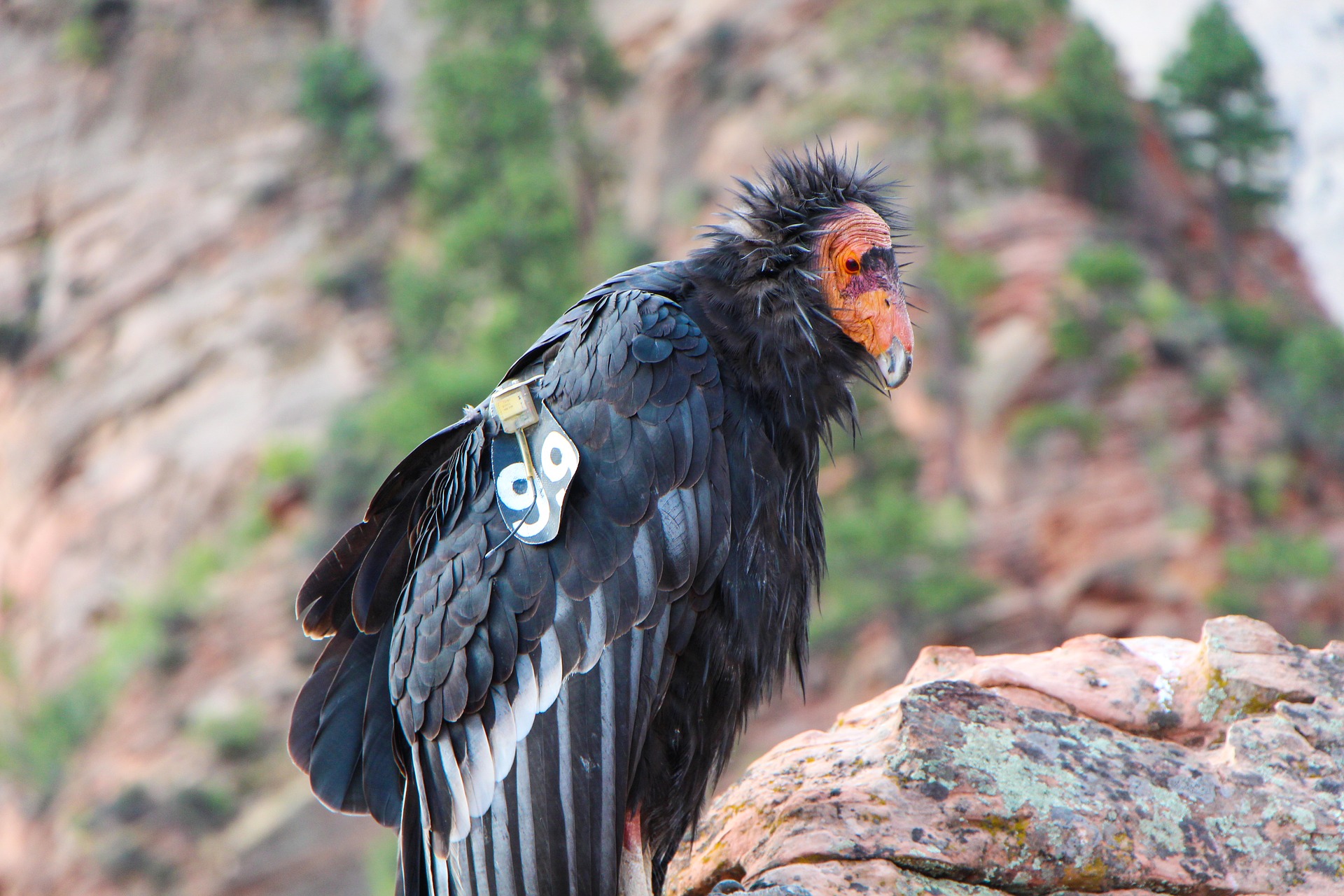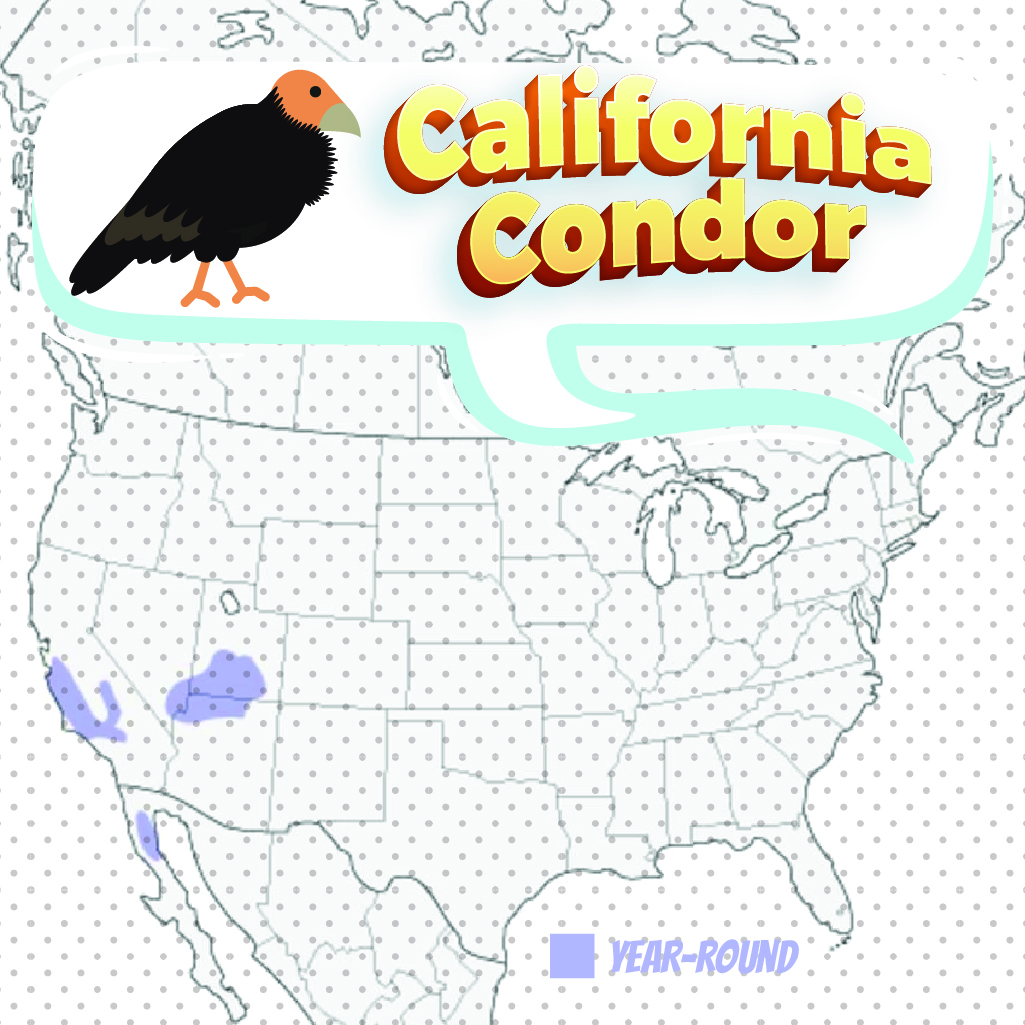
California Condor
A California Condor is a fun bird to see while bird watching. Below are some tips to help you identify California Condors. We have also put together a list of fun California Condor t-shirts, California Condor bird patches, bird houses, bird feeders, binoculars, stickers and other fun bird watching items.
About California Condors
California Condor is the largest North American bird though slowly becoming endangered. They travel for long distances gliding through the skies feeding on dead animals and breed on high cliff faces. Their endangerment comes from lead poisoning in the 1980’s.
Description and Identification
The California Condor is famously known as the largest terrestrial bird in North America. They are identified by their naked heads and necks which are capable of changing colours to signal their emotional state to other birds of the species. There is a collar or frill made of black feathers at the end of its neck. The adult condors have dark black feathers which are interspersed with bands of white on the wings. They have a massive wingspan that can measure up to 11 feet. These birds have greyish-ivory beaks and dull grey legs. The central toe of its feet is elongated with straight talons which have evolved for walking. Juvenile birds have grey-brown feathers with darker coloured heads. The females of the species are generally smaller than the males.
California Condor Color Pattern
Adults have thick black colored feathers with white patches crossing under its wings. It has a bald head with grey heads for the younger ones and orange for adults.
California Condor Size
Being the largest bird in North America, they have extremely long wings with its primary feathers giving a depiction of fingers. Respective measurements include:
- Length 117- 134 cm
- Weight 7000-9900 g
- Wingspan 277cm

California Condor Behavior
The California condor is a master of soaring through the sky rarely flapping its wings and dominate the sky with its solid and heavy appearance. They are naturally social birds forming flocks around feeding grounds and water sources as they bathe. Condors bathe frequently and hold competitions to decide on a hierarchy within the flock which is seen during feeding.
What California Condors Eat
California condors are intermittent eaters which means that they can go without eating for a few days after feasting on a large meal. They can travel for distances as long as 160 miles a day in search of suitable food. These birds are scavengers that feed on carrion. They prefer large terrestrial animals like goats, pigs, or bears. They can also vary their diet to feed on the dead flesh of smaller mammals like rabbits and coyotes. They rarely ever feed on reptiles or other birds. They rely on their eyesight to follow other scavenging birds and animals to a potential meal. Their strong beak is built to tear open the hide of dead animals in order to feed on their flesh. They can consume as much as 3 pounds of meat at a time.
They are basic scavengers feeding on the dead bodies of deer, horses, and bears. Condors may also feed on smaller animals such as rabbits and aquatic life such as whales and sea lions. They observe other birds of prey like the vulture which lack the efficiency of the condor to tear through the hide of some of these large animals.
Where California Condors Live and Their Habitat
California Condors frequent different temperate and dry zones. They can be found in shrublands, savannas, and coniferous forests. They nest at high altitudes in places like cliffs or on large trees. The birds travel large distances and the range across an individual’s home territory can highly vary. Sanctuaries have been set up to protect these critically endangered birds to create a new habitable environment for them.
California condors live in arid shrublands, near cliffs and very tall trees which they use to build their nests. Due to their size, they may have trouble taking off so they take advantage of windy areas where they dive from high cliffs to take flight.
Range and Migration

Historically, California Condors occupied a large territory all across North America. Fossil evidence has pointed to these condors being found in places as far to the south-eastern borders as Florida and in other regions like Nevada and New Mexico. The mass extinction of large animals during the end of the ice age reduced the food availability of these birds and restricted them to smaller ranges. After their extinction in the wild, they were reintroduced to places like Arizona, Utah, and the coastal mountains of California. They are generally non-migratory birds but can fly great distances to forage.
Nesting
The nests of California Condors are usually found in natural cavities. The mated pair make a simple nest in places like caves or the clefts on the side of cliffs. Some birds also choose to nest on top of large trees like the native redwood and sequoia trees. They choose a roosting place that is open enough to let the large birds land and lay their eggs. The females lay one bluish-grey egg every alternate year in their makeshift nests.
California Condor Lifecycle
Condors have a large territory with multiple nesting sites but the females decide on which location will be used next. Their breeding age is six where the male courts the female by turning his head red and puffing out his neck feathers all while spreading his wings slowly. The female, in turn, bows down and the two pair up for life. The female lays only one egg which hatches after 53 to 60 days of incubation. The condor lives up to 60 years and always reaches adulthood.
Ornithology
Bird Watching Academy & Camp Subscription Boxes
At Bird Watching Academy & Camp we help kids, youth, and adults get excited and involved in bird watching. We have several monthly subscription boxes that you can subscribe to. Our monthly subscription boxes help kids, youth, and adults learn about birds, bird watching, and bird conservation.
Bird Watching Binoculars for Identifying California Condors
The most common types of bird watching binoculars for viewing California Condors are 8×21 binoculars and 10×42 binoculars. Bird Watching Academy & Camp sells really nice 8×21 binoculars and 10×42 binoculars. You can view and purchase them here.
California Condor T-shirts
If you love the California Condor you should purchase a Bird Watching Academy & Camp T-shirt. To help support bird conservation we donate 10 percent to bird conservation activities.
California Condors Iron On Patches
Kids, Youth, and Adults love to collect our Bird Watching Academy & Camp iron on patches. Our bird watching patches help you keep track of the birds you have seen an identified. You can also display the patches on our Bird Watching Academy & Camp banners.
The California Condor is a great iron on patch to start your collection with. The patches are durable and can be sewn on or ironed on to just about anything.
California Condor Stickers
Stickers are a great way for you to display your love for bird watching and the California Condor. We sell a monthly subscription sticker pack. The sticker packs have 12 bird stickers. These sticker packs will help your kids learn new birds every month.
Bird Feeders For California Condors
There are many types of bird feeders for California Condors. Here are some of our favorites. There are many types of bird feeders. Here are our favorite bird feeders for your backyard. We use all of these bird feeders currently. Kids will have a great time watching birds eat at these bird feeders. Using this collection of bird feeders will provide a wide variety and many types of birds.
Best Bird Houses for California Condors
There are many types of bird houses. Building a bird house is always fun but can be frustrating. These 4 bird houses have become our favorites. Getting a bird house for kids to watch birds grow is always fun. We spent a little extra money on these bird houses but they have been worth the higher price and look great.











